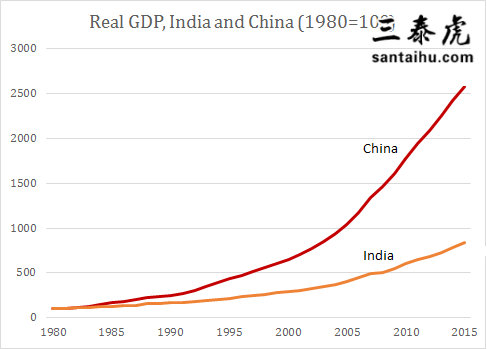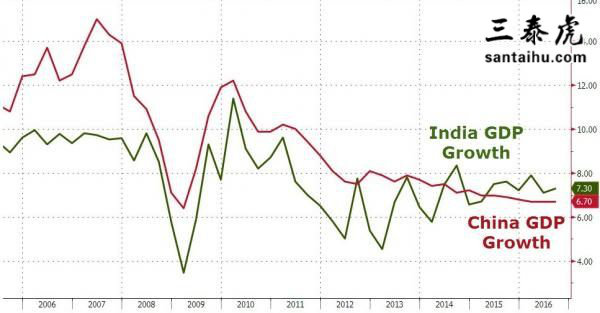Anonymous
To be frank India would never gonna beat in living standards.
’s GDP is USD 11.4 trillion (2016; IMF). India’s GDP is USD 2.25 trillion (2016; IMF). These economies are in no way comparable. The economy is more than 5 times larger. ’s GDP per capita stands at USD 8,260 and that of India at USD 1,718. ’s population (1.37 billion) and the population of India (1.34 billion) are comparable — but is five times richer on a per capita basis.
Based on these figures, India will add USD 129 in economic output on a per capita basis if it grows at a pace of 7.5%. Similarly, if grows by 6.3%, its output will increase by USD 520 per capita.
Those who say that India is home to the world’s largest economic growth have not even done primary school math on the situation. India actually needs to grow at more than 30% to outpace in absolute terms per capita.
坦率地说,印度人的生活水平永远超不过。
的GDP是11兆4000亿美元(2016;国际货币基金组织)。印度的GDP是2兆2500亿美元(2016;国际货币基金组织)。这两个经济体是不能相提并论的。经济规模是经济的5倍多。均GDP为8260美元,印度人均GDP为1718美元。的人口(13.7亿)和印度的人口(13.4亿)相当,但的人均财富是印度的五倍。
根据这些数字,如果印度以7.5%的速度增长,人均经济产出将增加129美元。同样,如果增长6.3%,其人均产出将增加520美元。
那些说印度是世界最大经济增长国的人,肯定压根没做过小学数学方面的研究。印度实际上需要凭借超过30%的增长率才能在人均绝对值上超过。
If one assumes that India continues to grow at a rate of 7.5%, and at a rate of 6.3% from here on out, it will take 127 years before India’s per capita growth will actually begin to exceed ’s.
The problem is that many people confuse “rate of growth” with actual “growth.” They blithely assume that a higher growth rate means greater growth. They assume that a decline in the growth rate is a decline in growth. Perhaps people simply see what they want to see as a result of their ideological preferences.
如果假设印度继续以7.5%的速度增长,从现在起以6.3%的速度增长,那么印度的人均增长真正超过需要127年的时间。
问题是许多人把“增长率”和实际“增长率”混为一谈。他们兴高采烈地认为更高的增长率意味着更大的增长。他们认为增长率的下降是经济增长的下降。也许,人们只会根据意识形态偏好选择性地看到他们想看到的结果。

and India, history of real GDP expansion since 1980
In the early 1980s, India was richer on a per capita basis than — India’s population was much smaller than ’s, but its GDP was of similar size.
If one pores over statements released by international institutions and media reports published over the past 36 years, it was consistently claimed that while India would be slow in getting to this point, it would eventually outpace .
Not only did this not happen, but as demonstrated above, by now it looks as though it will be virtually impossible for India to outpace . One should pause to reflect on why so many have been so consistently wrong about India.
和印度自1980以来的实际GDP增长记录
在20世纪80年代早期,印度的人均财富要比富裕——印度的人口比少得多,但国内生产总值(GDP)规模相近。
如果人们对过去36年国际机构发表的声明和媒体报道不以为然,那么人们会一直认为,尽管印度在这方面进展缓慢,但最终将超过。
但这不仅没有发生,而且如上所述,现在看来印度几乎不可能超过。人们应该停下来反思以下,为什么这么多人对印度一直抱有错误的看法。
India’s Problems Have Deep Roots
India is an extremely irrational, superstitious, and tribal country. The concept of reason is mainly conspicuous by its absence in much of India. India was long associated with Britain and has imported western institutions, ways of living, technology, etc., over the last 200-300 years, but has failed to import the concept of reason.
The same could be said for Africa, the Middle East, rest of South Asia and most of South America. But we will stick with India here. Without the concept of reason, people can have no understanding of the rule of law, of fairness, or simply of what is right or wrong.
They can only think in terms of might is right, street-smartness and political connections. Such a society cannot have any understanding of the principles of the ten commandments, or have respect for the individual and liberty.
印度问题根深蒂固
印度是一个极端非理性、迷信和种族的国家。印度长期以来与英国纠葛在一起,并在过去200-300年间引进了西方机构、生活方式、技术等,但未能引入理性的概念。
非洲、中东、南亚其他地区和南美洲大部分地区也是如此。没有理性的概念,人们就不可能理解法治、公平,甚至分清什么是对,什么是错。
他们只能通过实力、街头智慧和政治关系来思考。这样的社会不能理解十诫的原则,也不能尊重个人和自由。
In the last three decades, India’s economy has grown, but most of this growth can be attributed to significantly improved access to the western world and its technology through the new medium of internet and cheap telephony. The low-hanging fruit from this have been plucked and India is starting to show signs of stagnation.
While India grew economically, government grew at an even faster rate. People and corporations took on debt faster than they could repay it. They imported the lifestyle and a generous hel of consumerism from the West, mostly its entertainment aspects. Reason fell by the wayside.
All evidence indicates that Indians were actually disincentivized from develo critical thinking, creativity and reasoning skills. Why bother when one could become rich without them?
Indian manufacturing plants or offices, including those in the private sector are chaotic, wasteful and incapable of planning and following a system as a result. Labor costs appear cheap, but India’s chaos ensures low productivity.
Given a chance, Indian companies prefer to move their factories to . Indian cities and villages are packed with good, even very basic ones.
在过去的三十年中,印度的经济已经增长,但是这种增长大部分可以归因于通过互联网和廉价电话的新媒介显著改善了对西方世界及其技术的访问。印度开始显示出停滞的迹象。
当印度经济增长时,政府的增长速度甚至更快。人们和公司承担的债务比他们偿还的要快。他们引入了西方的生活方式和大手大脚的消费观念。理智被抛在一边。
所有证据都表明,印度人实际上缺乏发展批判性思维、创造力和推理能力的动力。为什么没有人可以变得富有呢?
印度的制造厂或办公室,包括那些私营工厂或办公室,是混乱、浪费的,无法规划和推行一个系统。劳动力成本看似便宜,但印度的混乱导致了生产率低下。
如果有机会,印度公司宁愿把工厂迁到。印度的城市和乡村都挤满了商品,甚至是非常基本的日用品。
What Will India’s Future be Like?
It shouldn’t be too difficult to abandon the idea that India will be the next . India’s much-celebrated growth of 7.5% is too low to make any real impact on the world economy. But even this is under massive threat, once considers the country’s institutional and cultural problems.
As mentioned earlier,India has failed to cultivate critical thinking and hence the ability to develop its own technology.
India has been a massive beneficiary of the fall in oil price, as oil is by far its biggest import. This was a one-off gain, a benefit for growth that will trail off again. Indian exports are already showing signs of strain and are falling, partly losing out to other countries which continue to improve their competitiveness, such as and the Philippines.
Members of India’s middle class have become remarkably arrogant, thinking that there must be something special about them that made them so much richer, but they were merely lucky beneficiaries of western technology. This arrogance has boosted nationalism, which is spreading like wildfire.
In a society lacking in rationality, nationalism is not perceived to be about human values but is a mere geographical, tribal concept. Hindutava (Hindu-nationalism) has been on the rise. The BJP, the party representing this ideology, has come to power two and half years ago, with Narendra Modi as the prime minister.
印度的未来会是什么样子?
放弃印度可能成为下一个的想法应该不会太难。印度著名的7.5%增长率还是太低,无法对世界经济产生任何真正的影响。但只要考虑到这个国家的制度和文化问题,这个增长率也面临着巨大的威胁。
正如前面提到的,印度未能培养批判性思维,因此也未能培养发展自己技术的能力。
印度一直是石油价格下跌的受益者,因为到目前为止,石油是其最大的进口产品。这是一次性的收益,对经济增长的好处将再次减少。印度的出口已经显示出紧张的迹象,开始下降,部分输给了其他继续提高竞争力的国家,如和菲律宾。
印度中产阶级已经变得非常傲慢,他们认为一定有什么特别的东西使他们变得如此富有,但是他们只是西方技术的幸运受益者。这种嚣张气焰助长了民族主义,这种野心正在蔓延。
Conclusion
It should be easy to see that India is not the next . There is no point in holding out much hope for India. Rather, it is ever easier to conclude that it is on the way to becoming the next banana republic, similar to neighboring countries such as Pakistan, Bangladesh, Myanmar or Nepal.
结论
很容易就能看出,印度不会成为下一个。对印度寄予厚望是没有意义的。相反,人们更容易认为,印度正在沦为下一个香蕉共和国,类似于邻国,如巴基斯坦、孟加拉国、缅甸或尼泊尔。

Intellectuals should engage in some self-reflection on why they have been consistently wrong about India. It is that exhibits continued economic and social growth. keeps coming out with innovative products. In ’s book shops one can find translations of many of the best foreign books. I’m worried that India could rapidly become a backwater by comparison.
知识分子应该对自己为什么长期错误地评价印度进行反思。经济和社会持续增长。不断推出创新产品。在的书店里,你可以找到许多最好的外国书籍的中文译本。相比之下,我担心印度很快就会变成一滩死水。
外文链接:https://www.quora.com/What-are-s-advantages-over-India
此文由 三泰虎 编辑,未经允许不得转载!:首页 > 印度 » 中国对印度有什么优势

 印度空军重新调整现代化计划,推动“印度制造”
印度空军重新调整现代化计划,推动“印度制造” 印度新冠肺炎确诊病例突破10万例,死亡病例超过3000例
印度新冠肺炎确诊病例突破10万例,死亡病例超过3000例 印度财政部长:可以通过多种形式把钱发到人们手中
印度财政部长:可以通过多种形式把钱发到人们手中 印度食品部宣布:15天内向8000万民工发放免费口粮
印度食品部宣布:15天内向8000万民工发放免费口粮 印度开展药品外交,向拉美及加勒比海国家、非洲国家伸出援助之手
印度开展药品外交,向拉美及加勒比海国家、非洲国家伸出援助之手 你认为印度现在最需要什么
你认为印度现在最需要什么 印度北方邦卡车事故造成26名民工死亡,36人受伤
印度北方邦卡车事故造成26名民工死亡,36人受伤 印度北方邦两卡车相撞,致23名民工死亡
印度北方邦两卡车相撞,致23名民工死亡